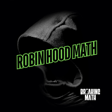Become a Creator today!Start creating today - Share your story with the world!
Start for free
00:00:00
00:00:01

44: Vestigial Math (Math That Is Not Used like It Used to Be)
Mathematics, like any intellectual pursuit, is a constantly-evolving field; and, like any evolving field, there are both new beginnings and sudden unexpected twists, and things take on both new forms and new responsibilities. Today on the show, we're going to cover a few mathematical topics whose nature has changed over the centuries. So what does it mean for math to be extinct? How does this happen? And will it continue forever?
This episode is distributed under a CC BY-SA license. For more information, visit CreativeCommons.org.
[Featuring: Sofía Baca, Gabriel Hesch]
---
This episode is sponsored by
· Anchor: The easiest way to make a podcast. https://anchor.fm/app
Support this podcast: https://anchor.fm/breakingmathpodcast/support
Transcript
Introduction to Vestigial Math
00:00:00
Speaker
Mathematics, like any intellectual pursuit, is a constantly evolving field, and like any evolving field, there are both new beginnings and sudden unexpected twists, and things take on both new forms and new responsibilities. Today on the show, we're going to cover a few mathematical topics whose nature have changed over the centuries. So what does it mean for math to be extinct? How does this happen? And will it continue forever? I'll listen more on this episode of Breaking Math, episode 44, Vestigial Math.
Meet the Hosts: Sophia and Gabriel
00:00:35
Speaker
I'm Sophia. And I'm Gabriel. And you're listening to Breaking Math. First, we got some plugs.
Support and Contact Information
00:00:42
Speaker
If you want to support the show, you can support us on Patreon.com slash Breaking Math. We're putting up ad-free versions of the episodes for the $5 tier or more, and also the outlines for the show. And if you donate probably to the E dollars every month, which is $22.46, you can get our poster.
00:01:01
Speaker
Yeah, that's right. We're also selling our poster on our Facebook as well. That's facebook.com slash breaking math podcast. You'll also see a lot of Sophia's phenomenal Photoshop work. We do a lot of mathematical memes that we take great pride in. There's a lot of humorous stuff up there as well as some, yeah, some, some great pictures and, and, uh, um, there's some visual stuff that you just can't get on a podcast.
00:01:23
Speaker
Yeah, and you can buy the poster there too for $22.46 and we got the shipping handling down to $6.25. So if you're looking for a holiday gift for someone who likes Einstein, or likes vector calculus, or just like vector analysis at all, or you know, just likes having kind of a fancy poster, I'd suggest buying that.
00:01:46
Speaker
Yeah, the posture looks great on anyone's wall, especially those who like math and physics. It's just a great piece to have and a great conversation piece. Oh, yeah. And of course, we have, if you want to look at more visuals, like interactive visuals, you could go to breakingmathpodcast.com and you could contact us on Twitter at BreakingMathPod.
00:02:07
Speaker
and breakingmathpodcastatgmail.com. You can send us your inquiries, favorite problems, because I mean, we started doing the problem episodes and we might put some inquiries on there. We haven't really decided what to do with those, so we'd like your feedback. Yeah, actually, I'll even second that. If you have a favorite math problem of all time or a couple of favorites, please send them. We'd love to read them. We'll email back to you. And as Sophie alluded to, perhaps we'll do a problems episode on them if it's a good fit.
00:02:36
Speaker
I think that'd be a really cool idea, but we'd we'd love to hear from you for sure.
Why Does Math Become Obsolete?
00:02:40
Speaker
It's kind of weird that math can seem to go extinct. Yeah. Yeah. And do you mean math or I suppose forms of math or subsets of math?
00:02:49
Speaker
Yeah, I think I mean like mathematical techniques. And the reason why we're calling this vestigial math instead of extinct math is because I mean like a whale, for example, they still have hip bones and they still use them for mating, but they don't support their weight anymore. So like all of these things, they're still valid math. It's not like the math doesn't work anymore, but it's just we have better tools for certain things. It's kind of like Roman numerals. I mean, that's a really simple example of a notational system that's not used anymore.
00:03:19
Speaker
Yeah, yeah, absolutely. This is sometimes in movies and stuff, but sorry. Oh, no, it's all good. So this actually, this episode, this topic hits at the core of why I wanted to start this podcast in talking about math and culture and talking about communication and human language, all of those elements. And part of that is just where you've got a method of math, of measurement or of counting,
00:03:44
Speaker
and then it has some purpose, but then it goes extinct because of a better way of counting or, oh gosh, how do I say this? Our understanding changes and then our old tools are no longer useful.
00:04:01
Speaker
Yeah. Cause I mean, math is, uh, math isn't itself a tool. I don't believe. So I believe math kind of exists in a weird pure space, but the way that we do math is filled with tools. Absolutely. I mean, as you said earlier with Romans, they didn't have a symbol for zero. So obviously that's only useful for certain things.
00:04:18
Speaker
Oh yeah, definitely. For a lot of things, but it's just interesting how things change. Yeah, absolutely. And one of the things we'll talk about later on is if math has been shown in the past to be incomplete with Roman numerals or a lack of irrational numbers in ancient Greece, right now, today, how is math incomplete today that we are currently unaware of? That's an open question.
00:04:43
Speaker
Yeah, and I mean, and we know it has to exist a little bit because of Godel's and completeness theorem. But yeah, we'll get into all of that. The first thing we're going to talk about is Egyptian fractions.
Obsolete Techniques: Egyptian Fractions
00:04:57
Speaker
They're used in Egypt to measure fractional quantities and they are difficult to use. Yeah, they had a use for a while, but as we will see, very limited use and they can't do a whole lot once you get into more advanced math.
00:05:11
Speaker
After that, we're going to get into a topic called the method of mechanical means, which was used in ancient Greece. And it's, oh, would we say maybe a precursor to integral calculus? Oh, yeah. And it was so, it was considered so informal that it wasn't even published. It was just a letter that was found in 1906.
00:05:30
Speaker
Yeah, this is one of my favorite forms of extinct mathematics. It's just beautiful how they thought of these ways of solving for, what was it, volumes of strange shapes? Oh yeah, volumes of strange shapes. Yeah, like parabolas and things like that. And finally, we're going to go into Projective Geometry, which was invented in a prison cell.
00:05:52
Speaker
Yeah, that's a really fun one. I find that fascinating just like what inspires somebody in any time, whether you're in a comfort of your home or in a prison cell or somewhere else. There's just things that inspire people in all walks of life. So that's certainly a fun one to talk about. And then the last thing we're going to talk about is what current math is going to go extinct and why and how and all that. All right, so Egyptian fractions. So when did Egyptian fractions come about?
00:06:22
Speaker
Well, I mean, according to Wikipedia, the Middle Kingdom period of Egypt, which was about 1700 to 2000 BC, so almost 4,000 years ago. Isn't Wikipedia amazing? It just is. It's just one of the modern miracles.
00:06:39
Speaker
Oh yeah. And if you had Wikipedia at the time, maybe they wouldn't have used the system. So basically what it is, is it's to measure fractions. Because in ancient Egypt, mathematics, the first one was just numbers, like ones, tens, hundreds, and thousands. But instead of having, it wasn't a place value system like ours today. It was, they used a symbol, like if you wanted to write 63, you'd write the symbol for 10 six times and then the symbol for one three times. Okay. Interesting. Interesting.
00:07:09
Speaker
So, why did fractions arise in ancient Egypt? What use was it? Well, I mean, they had a complex legal system. They needed to build things like pyramids, I think agricultural planning, things like that. It was also used as a religious thing. There's this thing called the Eye of Horus, and you might have seen it before. It's the thing with the eyebrow and the weird curly cube below the eye.
00:07:36
Speaker
And that was used to draw fractions in the form of like binary fractions, like part of the I meant like one half, so part of the I meant like a quarter, part of the I meant one eighth, all the way to one 64th. Oh wow, interesting.
00:07:53
Speaker
and so that is obviously useful and the reason why is there's like a legend about the eye of Horus and that like the Egyptians literally had different doctors for left and right eyes but so they had a lot of religion having to do with this and with numbers like that it's pretty trivial anything like anything over 64 it's really easy to do that just one over two one over four one over eight
00:08:18
Speaker
But if you wanted to do like, let's say, let's say one third, you'd have to approximate that. So they quickly came up with a reciprocal fraction system. So where you'd write down the number and you'd write like a couple of lines below it or something like that to indicate that it was a reciprocal. So you'd write three and then something to indicate that it's one over three or one third. Interesting. Okay. Okay.
00:08:42
Speaker
Now, this might be a bit of a side tangent, but I'm quite curious. I had no idea that the ancient Egyptians had a doctor for each eye. What was part of their belief, just like...
00:08:51
Speaker
I think that the Eye of Horus is... Let me look that up real quick. Okay, so this is... I found the myth that I heard about it. When Set and Horus were vying for power, Set gouged out Horus's left eye, and the eye was restored, like half of it was restored, then like a quarter more was restored all the way, and I think only 1 64th of the eye was missing. It was a weird religious thing.
00:09:21
Speaker
Oh, how strange. So you're talking about statues? Is that right? Oh, no, these are just gods in their in their philosophy. Okay. So, oh, so this is a story. This is a myth. Yeah. Okay. Okay. Oh, yeah. No, set and orders are gods. Got it. I, of course, should have known that. I should have known that. Okay. Interesting.
00:09:40
Speaker
Yeah, in breaking math, we care about two things, math and Egyptian mythology. Yeah, exactly. So indeed, and we do not know everything, so we can be wrong from time to time, believe it or not. Either that or we intentionally put errors in our podcast for you to catch. Make sure you're paying attention. We don't.
00:09:58
Speaker
But yeah, and it's hard to use for basic stuff because they didn't have a way of representing like two divided by five. So like two divided by five, they wrote that as one third plus one fifteenth. There's no such thing as like one number over another. There's no fraction like that. Everything is just a sum of reciprocals. Oh, wow.
00:10:20
Speaker
Interesting. Yeah, like if you wanted to like do two over something It's the general formula for that was one over that thing plus one over twice that thing plus one over thrice that thing Plus one over six times that thing Wow that that gets convoluted very very quickly or in the words 2p or sorry 2 over p equals 1 over p plus 1 over 2 times p plus 1 over 3 times p plus 1 over 6 times p Yeah, that that gets that gets ugly very very fast
00:10:47
Speaker
It's so hard to actually add numbers in this system because like the fractions have pretty unique representations like 6 13ths for example in Egyptian fractions is 1 3rd plus 1 8th plus 1 312th
00:11:04
Speaker
Oh man, that would make things way too difficult. Yeah, whereas four thirteenths was one fourth plus one eighteenth plus one four hundred and sixty-eighth, there's not one number in common between those two representations. Jeez, so did they have like Egyptian mathematicians who just made these tables of all these functions? Oh yeah, tons of tables, yeah. Okay, I see.
00:11:25
Speaker
So basically the formula for 2 over p if p is prime is 2 over p is equal to 2 over p plus 1 which reduces to 1 over something plus 2 over p times p plus 1 Yeah, which also reduces to 1 over something so and that was just used when p is prime I'm pretty sure I mean that could be used I think whenever p is odd, honestly So are there things that we do now like this?
00:11:53
Speaker
I think so. I mean, I mean, like we said, math is tools and to think that we have the best tools, like just cause we exist is silly. Yeah. Yeah. Um, absolutely. So yeah. So, so nowadays there's plenty of areas of, of just really hairy mathematics that we don't really have a clean and elegant way of representing or of analyzing or representing like a fluid dynamics is one of them.
00:12:19
Speaker
Oh, yeah. Because fluid dynamics, it's like everything is moving and everything is moving everything. Like there are very few closed form solutions because we use it in the language of differential and integral calculus. But like who knows, there might be a way of analyzing fluid dynamics that we just don't know. I mean, turbulence is something that is still very poorly understood for this reason.
00:12:46
Speaker
Yeah. In fact, I think there was a mathematician who once said that when he dies and goes to heaven and can ask God any questions, he would ask him why quantum mechanics and why turbulence? And God will give him an answer for quantum mechanics. That may have been Feynman. Okay. Yeah. Yeah. Oh, no, though. Yeah. So turbulence is still a pretty wild field now. And again, it may be that we never have the tools to describe turbulence. I don't like to think that, but I mean, that very much is a possibility.
00:13:16
Speaker
Oh yeah, I mean it is a possibility as we'll discuss later because of the incompleteness theorem but I also think in a weird way it might be an impossibility that we'll never find any way to analyze it better because I mean fluid dynamics is a very large field right now I mean I know that like I mean it has been like for a long time since like the 1700s so I mean we keep discovering new things in it it's just I guess the question is when is the next earth shattering discovery in terms of it?
00:13:45
Speaker
Yeah. And I just love it because there's just no way to know that no way at all. It's like so many people around the world are chipping away at different parts and who knows when the next big discovery will be.
00:13:56
Speaker
Oh yeah, math is kind of like prospecting for gold or oil or something. Yeah, yeah, yeah, absolutely. I've read plenty of papers online, actually, of scientists who made great discoveries accidentally. Oh, that is just a great topic. Even like dark matter, I think it was a woman who was trying to search for something original, so she intentionally didn't do black holes, which is, you know,
00:14:18
Speaker
one of my favorite topics and she just chose some area of space to study looking for possible anomalies and from that she discovered dark matter actually. There's more to the story but accidental discoveries are fascinating. I don't mean to go off on this tangent here in this episode but it you know does relate to the question of how will mathematics as we know it now change in the future. We don't know.
00:14:41
Speaker
Yeah, and although now we have fractions that are easy, now we don't have to have a PhD to do two-fifths exaggeration. But Paul Erdos, for example, who is the most prolific mathematician of all time, even more than Euler in terms of number of papers, one of his early results is he proved that there's no harmonic progression to form an Egyptian fraction representation of an integer, which means that
00:15:11
Speaker
Alright, a harmonic progression is like, is the opposite of an arithmetic progression. So an arithmetic progression is like 1, 2, 3, 4, or like 3, 6, 9, or like 4, 7, 10, things like that. So it's saying that 1 over an integer is never equal to 1 over like 2 plus 1 over 4 plus 1 over 6 plus 1 over 8 or anything like that. 1 over 11 plus 1 over 22, anything.
00:15:38
Speaker
Hey, Breaking Math fans. First, I want to thank you for listening. I have an important message for everyone. You can start your own podcast right now with Anchor. Anchor lets you create and distribute your own podcast. Just get an idea, record, and upload. It's just that easy. Anyone can do it. I'm on my way to accomplishing my dream, and you can too. Just get on your device's app store and download Anchor. It contains everything you need to make a podcast. With Anchor, you can put your podcast on all the big platforms.
00:16:07
Speaker
Apple Podcast, Spotify, Google Podcast, Amazon, and more. Reach the whole world with Anchor. Best of all, Anchor is free. You have nothing to lose with a free platform. Download the Anchor app or go to anchor.fm to get started.
Ancient Methods: The Method of Mechanical Means
00:16:27
Speaker
For our next section, we're going to talk about a topic in mathematics called the method of mechanical means that is also a vestigial branch of mathematics that is no longer used since the dawn of integral calculus. Still, this is one of my favorite topics, and I'm really glad we get to talk about it today. Well, even at the dawn of integral calculus, it wasn't used because it was lost to time. It was a letter written from Archimedes to Eratosthenes that delineated it.
00:16:52
Speaker
but it wasn't actually published as a regular treatise. It went actually undiscovered until 1906. Oh my goodness. Where was it discovered at that time? I don't know. Hold on.
00:17:04
Speaker
It was discovered in the Archimedes Palimpset, which was a Byzantine Greek copy of a bunch of Archimedes' works. And a lot of the text is erased, replaced with a religious text, which is common at the time, because pages were so expensive, they were made out of cows. Oh, wow. I had no idea.
00:17:29
Speaker
So what happened in 1906 where it turned up? Was it traded somewhere and somebody recognized it and the value of it or what? The biblical scholar Konstantin von Tischendorf visited Constantinople in the 1840s and he saw a little bit of Greek math on it so he brought it home and apparently nothing really happened until 1899 where they're like, oh crap, this is Archimedes.
00:17:58
Speaker
Oh, wow. That would be quite the discovery. Oh my goodness. Yeah. And then, uh, um, it was studied in 1906. God, things moved slowly back then. Wow. Yeah. Yeah. Absolutely. 60 years from discovering. Yeah. From discovering the artifact to it being known in the larger academic community. It took 60 years, which is insane. Wow. Yeah. Yeah. Yeah. That's crazy. Isn't it wild? Just how, how academia works, you know, how discoveries worked.
00:18:28
Speaker
Oh yeah, like I mean, even like Euler, they were publishing his work for 80 years after he was dead or something like that. Wow, that's crazy. Alrighty, so let's talk a little bit about what the method of mechanical means is.
00:18:41
Speaker
Oh, yeah. So it's basically used to figure out the area and volume of things. And by things, this method would be used for like, uh, strange shapes, as we said earlier, like barrels. Is that right? Uh, barrels or like, um, parabolas. Um, I'm pretty sure that he used that for, to discover his formula for the sphere before proving it rigorously. Okay. Okay. Interesting. Interesting. Okay. So let's give an example of something that you can solve using this method.
00:19:08
Speaker
So basically, the basic concept of this is that you can figure out how to find the area, the volume of things, and it involves dividing a shape into infinite slices. Which is still what we do in calculus today. And they call them indivisibles. And so the idea is that if you know the center of gravity of two shapes, and you know that they can balance on a lever,
00:19:36
Speaker
then you know the ratio of the areas between them or the volumes or whatever you're finding out. So for example, I'm pretty sure to measure a parabola. So let's say you want to measure a parabola's area. You divide that into an infinite number of slices and you kind of draw a triangle around it. Maybe we'll discuss this on the next problem episode.
00:20:01
Speaker
but you draw the triangle around it, then you cut the triangle into infinite slices, and you show that each slice in the triangle has a different unique slice in the parabola, and that they balance each other out. Basically, each piece balances out, and since each piece balances out, it means that we know the ratio. Interesting. I, for one, was not aware that they had concepts of infinity in ancient Greece.
00:20:29
Speaker
Oh yeah. Like, I mean, they, they, not like super rigorously all the time, but like, they definitely had the concept. I mean, there's Zeno's paradox. Um, there's like Achilles in the tortoise. That's right. So actually I was aware. Sorry, I forgot it happens. I guess my question right now is that, so you start, you starting with the parabola, how do you get the triangle that's equivalent to it? You know what I mean? Like.
00:20:53
Speaker
Oh, yeah. I mean, like, I mean, you do kind of have to guess it's like any other math in that sense, and use intuition and stuff. But once you have that, you can kind of play around with it. And like, you get a feel for it pretty quickly.
00:21:08
Speaker
Now, this was used for non-rigorous mathematics. That is to say, this method of mechanical means wasn't considered a rigorous proof of anything. However, it was used to discover things and then to prove it rigorously, something called the method of exhaustion was used.
00:21:25
Speaker
Yeah. And exhaustion is kind of like, um, like you can prove, uh, things like, uh, like that a cylinder is equal to the area of, uh, the circle times the height. Now we say the circle, you mean a circle that is within a cylinder.
00:21:40
Speaker
Yeah the circle the size of the cylinder and the way that you do that is that you say you circumscribe the circle with the polygon meaning that you make a polygon where the points touch the inside of the circle and then you do another polygon of where the points where the lines touch the outside of the circle so basically you have one shape that's bigger than the
00:22:04
Speaker
than the cylinder and one shape that's smaller than the cylinder. And you show that it is not more than this. It is not more than the upper bound and not less than the lower bound. And then you prove that the upper bound and lower bound are equal. Equally at which point though.
00:22:20
Speaker
we prove that it cannot be greater than whatever the upper and lower bound is and it cannot be less than that. So since we already know that with the polygon that it's equal to the area of the cross section times the height,
00:22:36
Speaker
we could say that, okay, the inscribed polygon approaches the area of the circle, and so does the circumscribed polygon. And therefore, since it's between those two, and since those approach the area of the circle because of the idea that things that coincide are the same thing, it's a form of limits, very crude limits. Okay, I see. Interesting.
00:22:57
Speaker
Now, what you mentioned earlier, I think just as a side fact, Archimedes had said that he wanted his proof of the sphere and the cylinder, that the cylinder is, I'm sorry, that a sphere inscribed within the cylinder is exactly two thirds the volume. Was that right? Okay. He thought that was his most important mathematical discovery ever. And I believe he wanted that on his tombstone, if I'm not mistaken.
00:23:22
Speaker
Yeah, and I think they discovered his tombstone like a couple hundred years ago or something. Interesting. A few hundred years ago. Should we check that real quick? Sure. Okay, apparently it wasn't. They thought they did in the early sixties, but there's no compelling evidence. Okay, very good.
Projective Geometry: Poncelet's Prison Perspective
00:23:40
Speaker
So the last topic we're going to cover is projective geometry, which is the one that was discovered in a prison cell. So it was invented by Jean-Victor Poncelet, and he was kept as a POW during Napoleon's invasion of Russia in 1812.
00:23:58
Speaker
Now, who was he before he was captured and also who was he after he was captured? He was basically just a Someone who was in the Corps of military engineers And he became a lieutenant the French army the same year he graduated
00:24:16
Speaker
And then he was captured, of course, in Russia. And then after, you know, that he published his famous work. And then we and he became a professor in mechanics. So he was just kind of like a mechanical kind of person. Okay, very good. And his work. This is a fun one. I'm not going to try to pronounce this. And I know that you and I both went to just some random text to speech website. Okay.
00:24:41
Speaker
Very good. Do you want to try to pronounce his treatise? Oh, yeah. I think it was Treté Depropieté Projective de Figuere.
00:24:50
Speaker
And the translation of that is the treatise of the properties of projective figures. So, uh, basically he was in a cell and he saw the, um, the light on from his window move across the cell and he realized, um, that you can make math out of that. Uh, so the basic concept is that, so.
00:25:12
Speaker
You just see like a like if it was a perfect if the alignment was perfect between the source of the light like the Sun and the window Then you would see a square that looks just like the window with prison bars, right? So basically you'd see a bunch of rectangles. Is that right?
00:25:26
Speaker
Oh yeah. And those rectangles would be kind of like distorted. And so like, if you imagine, let's imagine you have a globe, right? And you put the globe on top of a grid and you put it so that the point that it touches the grid is the origin at zero, zero. And you put a light right at the top of the globe. You can look at the parts of the globe that get projected like onto the graph paper.
00:25:55
Speaker
And that correspondence is kind of what's used in algebraic geometry, I mean, in a projective geometry, because algebraic operations can be defined in these terms, for example, like every, like, it's kind of like in, I know it can be used for analyzing complex numbers, for example, because every point on the sphere maps to unique complex number. Very cool. So do you want to talk about the basic concept of this?
00:26:25
Speaker
Oh yeah, I mean, it's the type of geometry that can be done with just straight edges. Whitehead, who wrote the Principia Mathematica with
00:26:40
Speaker
with Russell, which was an ill-fated work that was supposed to describe all of math, and then Goodell was like, nope, you can't do that. But there's three axioms in projective geometry. Every line contains at least three points. Every two distinct points, A and B, lie on a unique line, AB.
00:27:01
Speaker
And if the lines AB and CD intersect, then so do lines AC and BD. Basically saying that if you have two lines that intersect together and you have two points on each line, then you can swap out the points. So like if they're horizontal kind of lines, you can make them vertical and that those lines will intersect as well. Okay. Interesting.
00:27:24
Speaker
Now I have a question about projective geometry as it's used here. I'm aware of Renaissance artists who would have a lot of hidden images in their paintings. For instance, there's a painting, and I forgot what the name of it is, but there's actually a skull painted in plain view. However, it's completely distorted. There's like, oh gosh, it's almost smeared across
00:27:48
Speaker
It looks like a rag. Yeah, exactly. But if you look at the painting almost sideways, it looks like a skull. It's pretty awesome. So would that be an example of projective geometry? Oh, yeah. It's a type of describing that. You could totally describe that with projective geometry. And projective geometry was kind of an intermediary form of math in many ways. Because analytic geometry, the geometry of Euclid and people like that,
00:28:17
Speaker
Very concrete kind of geometry. And then you have algebraic geometry on the other side, which is just the study of zeros. Zeros being like... If you have a certain figure, where does it intersect another one? That's kind of a zero. Just a side note, this was also discovered around the time that Galois theory was discovered by that guy who died when he was like 22.
00:28:38
Speaker
And both of them were kind of links between geometry and algebra. And basically today use group theory for most things they use projective geometry for, but it's not a totally dead form of math. Like for example, the Fano plane is a type of projective plane and it's literally so simple it's made out of seven points.
00:29:03
Speaker
And it can be used to describe things like matroids, which are a generalization of matrices. So that basically wraps it up for our discussion on projective geometry.
00:29:15
Speaker
The last question in today's podcast is a bit of a self-reflective question than it may not have any answers currently.
Future Obsolescence in Mathematics
00:29:22
Speaker
But all this talk about branches of mathematics and aspects of mathematics that are relics and no longer used brings up the question, what current math is going to go extinct?
00:29:35
Speaker
Yeah, I think honestly it's like, it's like, I think it's kind of like saying like, what's next technology that will have a revolution, you know? It's like we don't know. I think it's almost, I mean, I think it's almost like rigorous. I mean, it is rigorous that we don't know. I mean, Goodell's incompleteness theorem states that there's no one axiomatic system for all of math.
00:29:56
Speaker
And so, I mean, essentially, it states that. And like, that means that there's like so much stuff to discover, like, it shows that no, there's no monopoly on truth, really. Yes, yes. And also, as you mentioned, Godel's incompleteness theorem, it proves, it proves essentially that everything
00:30:15
Speaker
everything always has blind spots from that. Perhaps we can surmise that everything can be improved in various ways. So the possibility of things being approved obviously is there. We just have no idea how or why. I mean, we can certainly speculate, which is what we're doing in this section.
00:30:36
Speaker
Oh yeah. And like, and it's kind of weird too. Cause mathematics changed form pretty significantly around the time of Goodell. It's kind of weird that, um, the time at which you can no longer be a master of all mathematics and, uh, the time that it was discovered that no one set of axioms could describe all the mathematics where, uh, we're around the same time. It's just kind of fun. Yeah. Yeah, absolutely. Like it's a weird kind of like almost cosmic thing.
00:31:05
Speaker
Yeah, yeah, there will always be things left to discover, which is cool, which is cool, I think. I think that's encouraging because if things were done, it's like what now, you know? Oh, yeah, right. Yeah. Yeah, it's funny. I read a science fiction story where it turns out that humans were one of the only species who came up with Godel's incompleteness theorem.
00:31:27
Speaker
because humans in this were obsessed with limits and they talked about in the story how aliens had a different form of Relativity that didn't rely on limitations and like it just I mean and that gets into the idea like you know what like I mean, there's also kind of like the idea of like
00:31:50
Speaker
diversity that exists within mathematics now, I think it's almost impossible to not have diversity because if you can't know all of math, then you're always going to be able to discover new techniques. And those techniques, like if you take any two ideas and mash them together, you get a new idea.
00:32:06
Speaker
One of the things that we mentioned earlier in this episode is we talked about how Egyptian fractions got real, real hairy, real fast, and there's just certain things that were very, very difficult to do. I think there are definitely areas in mathematics right now, mathematics and physics, that get very hairy, very fast. Things like trying to describe turbulence, for example.
00:32:27
Speaker
So, you know, that's this is just, you know, you know, like an open question. Will there be a day that we better understand turbulence? I don't know. I have no idea. As we were saying earlier, there was a mathematician or was it a physicist who once said
00:32:41
Speaker
Yeah, I think it was a physicist. Okay, perhaps Feynman or something, who talked about when he dies and goes to heaven and talks to God and asks God a couple of questions. Those questions are going to be why quantum mechanics and why turbulence? And God will have an answer for why quantum mechanics, obviously implying that there's no answer for why turbulence. That's just a very, very difficult field.
00:33:02
Speaker
Oh, it turns out that was Heisenberg. I mean, it is really promising. And I, I think that looking back on mathematics and seeing so much improvement, it almost feels less hopeless that we will discover more because we've been doing it for, you know, 50,000 years. We're gonna, I don't see any stop.
00:33:20
Speaker
And you know, I think, I think one, one way we can end this podcast is we talk about the namesake of this podcast, breaking math.
Conclusion: The Evolution of Math
00:33:27
Speaker
It's always being broken and reinvented. So that's, that's a, we will make a prediction that that trend will continue. Oh yeah. And just like breaking news, when you discover something news, it is breaking math.
00:33:43
Speaker
Mathematics, although it is, in many ways, a perfect field, is also a field in which our understanding is limited by the tools we develop. We are, no doubt, going to discover things that make our current understanding of certain topics obsolete, but we won't know when that will happen until it has already happened, because mathematics is its own cutting edge.
00:34:03
Speaker
I'm Sophia. And I'm Gabriel. And this has been Breaking Math. Like you said, I'll send in your questions to at BreakingMathPod on Twitter or BreakingMathPodcast at gmail.com.
00:34:13
Speaker
Oh, and real quickly, I did want to take a quick moment and plug our last episode. It's a, it was a real, real fun idea. Um, we're, we're, we're starting a series of problems episodes on certain episodes. We will deep dive into a specific mathematical problem. And on our very first problems episode, which is the previous one to the one you're listening now or listening to now, we talk about calculus, specifically the chain rule. And we talk about a problem that Sophia invented.
00:34:40
Speaker
or came up with. And Sophia, do you want to do a quick summary of it? Oh, yeah, but just a quick correction. That was the second problem episode. The first one was the one on piano, piano zaxioms. But yeah, it was it's basically saying, if you're let's say you're walking a dog around a corner, and the dog and the dog sets the pace, what will your pace be after the dog turns the corner? It turns out that it's not constant.
00:35:08
Speaker
Yeah, and that really blew my mind. I thought, well, of course, it'll be the same thing as the dog. But again, there's some calculus involved here. Yeah, we're assuming, of course, like a leash that is kept taut and not a retractable leash either. Yes, exactly. And it's also the same problem is represented with a ladder that is being lowered down the side of a building where it forms a triangle. The ladder is a hypotenuse of a triangle.
00:35:34
Speaker
and it's being lowered at a constant rate. Oh yeah, like it's sliding down the wall at a constant rate. It's sliding down the wall such that the point that it touches on the wall is moving down at a constant rate. Yes, but that doesn't mean that the legs touching the ground are necessarily going at the same rate as the part that is touching the wall.
00:35:57
Speaker
Yeah, and you could kind of think about this intuitively. If you have a ladder that's almost vertical, you could imagine if there's a lot of friction on the ground, pushing it down would take a lot of effort. Whereas when it's almost horizontal, it takes almost no effort to move it down. So yeah, just thank you for listening to Breaking Math and send us your questions. And if you want to get a good holiday thing for someone, the poster is $22.46 on facebook.com slash Breaking Math podcast, $6.25 shipping handling, United States only.
00:36:27
Speaker
Um, and yeah, I guess, yeah. Great way, great way to end a podcast. Um, yeah, I guess. Yeah. I wish I could turn that into a meme. I'm going to put a quote of Sofia saying that. That'll be your famous saying as you go down in history. Um, yeah.



















